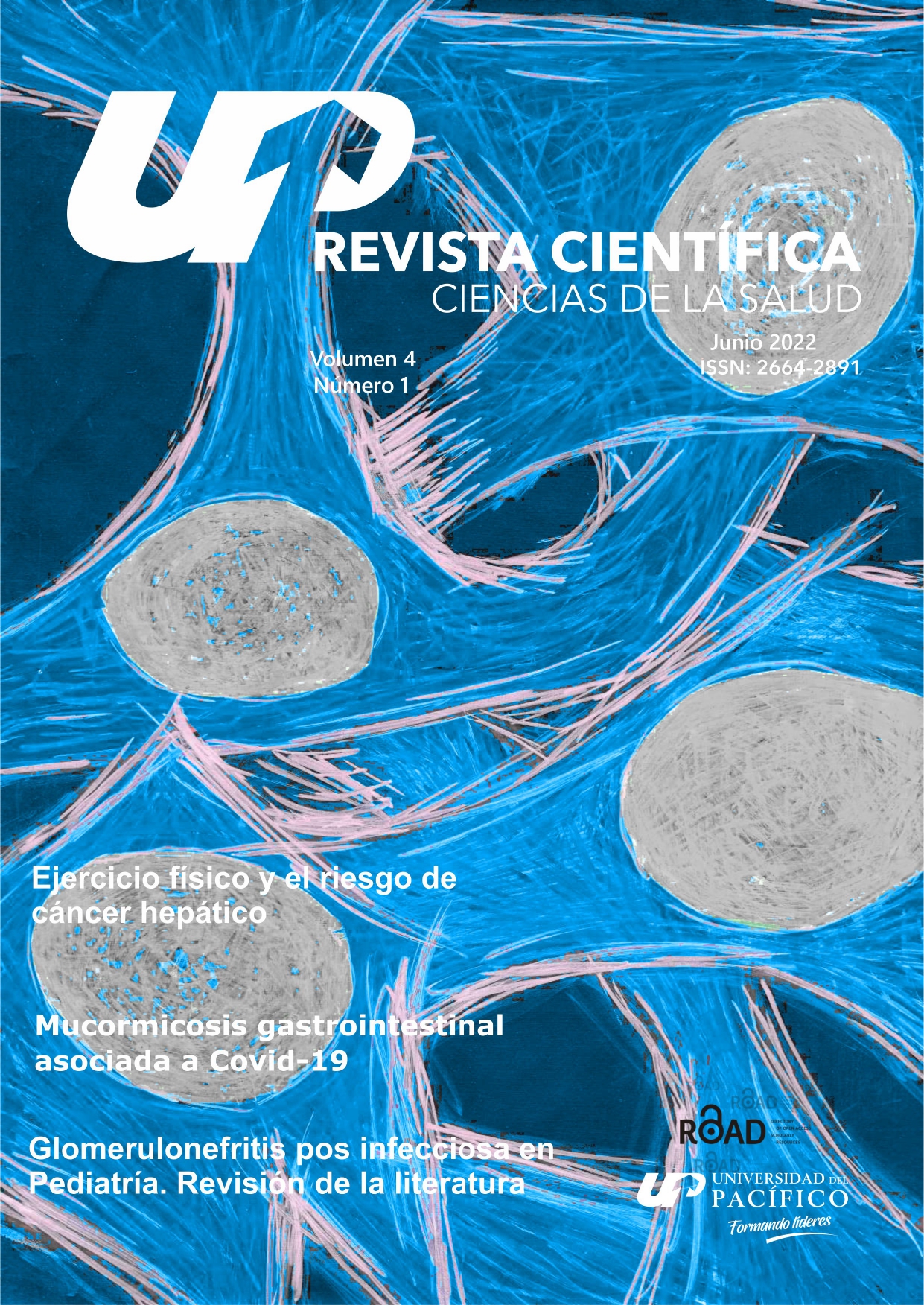Ejercicio físico y el riesgo de cáncer hepático
Physical exercise and the risk of hepatic cancer
DOI:
https://doi.org/10.53732/rccsalud/04.01.2022.24Keywords:
Hepatocelullar cancer, hepatic cancer, physical activity, non-alcoholic fatty liver diseaseAbstract
Introduction: The liver is the largest solid organ, it performs many functions in the body. Physical exercise is valued as an efficient non-pharmacological intervention in the promotion of physical, mental and functional well-being of cancer patients.
Objectives: To determine the effects of physical exercise on liver cancer and synthesize prospective studies on the association of physical activity and physical exercise with the risk of liver cancer.
Materials and Methods: Systematic review with retrospective and descriptive analysis of scientific articles published in indexed databases from January 2008 to June 2019. Likewise, the selection and evaluation of the archives was carried out through the Declaration of PRISMA, PICO, Cochrane and PEDro´s scale.
Results: It was found that physical activity is associated with a reduced risk of developing liver cancers (95% CI 0.38-0.80). Aerobic exercise reduced liver lipids (liver fat 8.9±3.2 to 5.6±1.8%; p= <0.05, visceral fat 54.7±6.0 to 49.6±5.5cm2; p= <0.05) 26.27 and resistance exercise increased insulin sensitivity (5.9 ± 5.9 to 4.6±4.6 vs. 4.7±2.1 to 5.1±2.5; p <0.05) improved metabolic flexibility (-0.0206 ± 0.010 vs. 0.004 ± 0.003; p <0.05).
Conclusions: Physical activity and exercise represents an important role in cancer disease, since it is associated with a lower risk of developing it, as well as reduce the symptoms that lead to liver cancer in particular
References
Las cifras del cáncer en España. Sociedad Española de Oncología Médica (SEOM). 2017. https://seom.org/seomcms/images/stories/recursos/Las_cifras_del_cancer_en_Esp_2017.pdf
¿Que es el cáncer?. American Cancer Society. 2020. https://www.cancer.org/es/cancer/aspectos-basicos-sobre-el-cancer/que-es-el-cancer.html
Global Cancer Observatory. International Agency for Research on Cancer. 2020. https://gco.iarc.fr
Marengo A, Rosso C, Bugianesi E. Liver Cancer: Connections with Obesity, Fatty Liver, and Cirrhosis. Annu Rev Med. 2016; 67:103-17. https://doi.org/10.1146/annurev-med-090514-013832
Llovet JM, Kelley RK, Villanueva A, Singal AG, Pikarsky E, Roayaie S, Lencioni R, Koike K, Zucman-Rossi J, Finn RS. Hepatocellular carcinoma. Nat Rev Dis Primers. 2021;7(1):6. https://doi.org/10.1038/s41572-020-00240-3
Zeng Y, Huang M, Cheng AS et al. Meta-analysis of the effects of exercise intervention on quality of life in breast cancer survivors. Breast Cancer. 2014; 21:262-74. https://doi.org/10.1007/s12282-014-0521-7
Holmes M. Chen W. Feskanich D. Physical Activity and Survival After Breast Cancer Diagnosis. JAMA. 2005; 293(20):2479-86. https://doi.org/10.1001/jama.293.20.2479
Bouillet T, Bigard X, Brami C, Chouahnia K, Copel L, et al. Role of physical activity and sport in oncology: Scientific commission of the National Federation Sport and Cancer CAMI. Critical Reviews in Oncology/hematology. 2015; 94(1):74-86. https://doi.org/10.1016/j.critrevonc.2014.12.012
Wolin KY, Schwartz AL, Matthews CE, Courneya KS, Schmitz KH. Implementing the Exercise Guidelines for Cancer Survivors. Journal of Supportive Oncology 2012; 10(5):171-7. https://pubmed.ncbi.nlm.nih.gov/22579268/
Hashida R, Kawaguchi T, Bekki M, Omoto M, Matsuse H, Nago T, et al. Aerobic vs resistance exercise in non-alcoholic fatty liver disease: A systematic review. J Hepatol 2017; 66(1):142-52. https://doi.org/10.1016/j.jhep.2016.08.023
Liberati A, Altman DG, Tetzlaff J, et al. The PRISMA statement for reporting systematic reviews and meta-analyses of studies that evaluate healthcare interventions: explanation and elaboration. BMJ; 2009; 339:b2700. https://doi.org/10.1136/bmj.b2700
Maher CG, Sherrington C, Herbert RD. et al. Reliability of the PEDro scale for rating quality of randomized controlled trials. Phys Ther. 2003; 83(8):713-21. https://pubmed.ncbi.nlm.nih.gov/12882612/
Arem H, Moore SC, Park Y, et al. Physical activity and cancer-specific mortality in the NIH-AARP Diet and Health Study cohort. Int J Cancer. 2014; 135(2):423-31. https://doi.org/10.1002/ijc.28659
Baumeister SE, Schlesinger S, Aleksandrova K, et al. Association of Physical Activity and Risk of Hepatobiliary Cancers: A Multinational Cohort Study. Journal of Hepatology. 2019; 70(5):885-892. https://doi.org/10.1016/j.jhep.2018.12.014
Inoue M, Yamamoto S, Kurahashi N, et al. Daily total physical activity level and total cancer risk in men and women: results from a large-scale population-based cohort study in Japan. Am J Epidemiol. 2008; 168(4):391-403. https://doi.org/10.1093/aje/kwn146
Moore SC, Lee IM, Weiderpass E, et al. Association of Leisure-Time Physical Activity With Risk of 26 Types of Cancer in 1.44 Million Adults. JAMA Intern Med. 2016; 176(6):816-25. https://doi.org/10.1001/jamainternmed.2016.1548
Yun YH, Lim MK, Won YJ, et al. Dietary preference, physical activity, and cancer risk in men: national health insurance corporation study. BMC Cancer. 2008; 8(366):1-17. https://doi.org/10.1186/1471-2407-8-366
Wen CP, Wai JP, Tsai MK, et al. Minimum amount of physical activity for reduced mortality and extended life expectancy: a prospective cohort study. Lancet. 2011; 378(9798):1244-53. https://doi.org/10.1016/S0140-6736(11)60749-6
Koya, S., Kawaguchi, T., Hashida, R., Goto et al. Effects of in-hospital exercise on liver function, physical ability, and muscle mass during treatment of hepatoma in patients with chronic liver disease. Hepatology Research. 2017. 47(3):E22–E34. https://doi.org/10.1111/hepr.12718
Aguiar e Silva MA, Vechetti-Junior IJ, Nascimento AF. Et al. Effects of swim training on liver carcinogenesis in male Wistar rats fed a low-fat or high-fat diet. Appl Physiol Nutr Metab. 2012; 37(6):1101-1109. https://doi.org/10.1139/h2012-129
Piguet AC, Saran U, Simillion C, Keller I. et al. Regular exercise decreases liver tumors development in hepatocyte-specific PTEN-deficient mice independently of steatosis. J Hepatol. 2015; 62(6):1296-1303. https://doi.org/10.1016/j.jhep.2015.01.017
Arem H, Loftfield E, Saint-Maurice, PF, et al. Physical activity across the lifespan and liver cancer incidence in the NIH-AARP Diet and Health Study cohort. Cancer Medicine. 2018; 7(4):1450–7. https://doi.org/10.1002/cam4.1343
Wen CP, Lin J, Yang YC, Tsai MK, Tsao CK, Etzel C, Huang M, et al. Hepatocellular carcinoma risk prediction model for the general population: the predictive power of transaminases. J Natl Cancer Inst. 2012; 104(20):1599-1611. https://doi.org/10.1093/jnci/djs372
Behrens G, Matthews CE, Moore SC, Freedman ND, McGlynn KA, Everhart JE, Hollenbeck AR, et al. The association between frequency of vigorous physical activity and hepatobiliary cancers in the NIH-AARP Diet and Health Study. Eur J Epidemiol. 2013; 28(1):55-66. https://doi.org/10.1007/s10654-013-9767-1
Kaibori M, Ishizaki M, Matsui K, Nakatake R, Yoshiuchi S, Kimura Y, Kwon AH. Perioperative exercise for chronic liver injury patients with hepatocellular carcinoma undergoing hepatectomy. Am J Surg. 2013; 206(2):202-209. https://doi.org/10.1016/j.amjsurg.2012.07.035
Johnson NA, Sachinwalla T, Walton DW, Smith K, Armstrong A, Thompson MW, George J. Aerobic exercise training reduces hepatic and visceral lipids in obese individuals without weight loss. Hepatology. 2009; 50(4):1105-1112. https://doi.org/10.1002/hep.23129
Van der Heijden GJ, Wang ZJ, Chu ZD, Sauer PJ, Haymond MW, Rodriguez LM, Sunehag AL. A 12-week aerobic exercise program reduces hepatic fat accumulation and insulin resistance in obese, Hispanic adolescents. Obesity. 2010; 188(2):384-390. https://doi.org/10.1038/oby.2009.274
Hallsworth K, Fattakhova G, Hollingsworth KG, Thoma C, Moore S, Taylor R, Day CP, et al. Resistance exercise reduces liver fat and its mediators in non-alcoholic fatty liver disease independent of weight loss. Gut. 2011; 60(9):1278-1283. https://doi.org/10.1136/gut.2011.242073
Zelber-Sagi S, Nitzan-Kaluski D, Goldsmith R, Webb M, Zvibel I, Goldiner I, Blendis L, et al. Role of leisure-time physical activity in nonalcoholic fatty liver disease: a population-based study. Hepatology. 2008; 48(6):1791-8. https://doi.org/10.1002/hep.22525
Bae JC, Suh S, Park SE, Rhee EJ, Park CY, Oh KW, et al. Regular exercise is associated with a reduction in the risk of NAFLD and decreased liver enzymes in individuals with NAFLD independent of obesity in Korean adults. PloS one. 2012; 7(10):e46819. https://doi.org/10.1371/journal.pone.0046819
Kistler KD, Brunt EM, Clark JM, Diehl AM, Sallis JF, Schwimmer JB. Physical activity recommendations, exercise intensity, and histological severity of nonalcoholic fatty liver disease. Am J Gastroenterol. 2011; 106(3):460- 8. https://doi.org/10.1038/ajg.2010.488
Krasnoff JB, Painter PL, Wallace JP, Bass NM, Merriman RB. Health-related fitness and physical activity in patients with nonalcoholic fatty liver disease. Hepatology. 2008; 47(4):1158-66. https://doi.org/10.1002/hep.22137
Hannukainen JC, Borra R, Linderborg K, Kallio H, Kiss J, Lepomaki V, Kalliokoski KK, et al. Liver and pancreatic fat content and metabolism in healthy monozygotic twins with discordant physical activity. J Hepatol. 2011; 54(3):545-552. https://doi.org/10.1016/j.jhep.2010.07.029
St George A, Bauman A, Johnston A, Farrell G, Chey T, George J. Independent effects of physical activity in patients with nonalcoholic fatty liver disease. Hepatology. 2009; 50(1):68-76. https://doi.org/10.1002/hep.22940
Moseley AM., Herbert RD., Sherrington C. Evidence for physiotherapy practice: a survey of the Physiotherapy Evidence Database (PEDro). Aust J Physiother. 2002; 48(1):43-9. https://doi.org/10.1016/S0004-9514(14)60281-6
Lee IM. La actividad física y la prevención del cáncer, los datos de estudios epidemiológicos. Med Sci Sports Exerc. 2003; 35(11):1823-7. https://doi.org/10.1249/01.MSS.0000093620.27893.23
H. Greenlee. Actividad física y cáncer del Aparato Digestivo Riesgo: Sigue persiguiendo la promesa. JAMA Oncología. 2016; 2(9): 1129-1131. https://doi.org/10.1001/jamaoncol.2016.1035
Berzigotti A, Saran U, Dufour JF. Physical activity and liver diseases. Hepatology. 2016; 63:1026-40. https://doi.org/10.1002/hep.28132
Keum N, Bao Y, Smith-Warner SA, Orav J, Wu K, Fuchs CS, et al. Association of Physical Activity by Type and Intensity With Digestive System Cancer Risk. JAMA Oncol. 2016;2(9):1146-53. https://doi.org/10.1001/jamaoncol.2016.0740
Aleksandrova K, Stelmach-Mardas M, Schlesinger S. Obesity and Liver Cancer. Recent Results Cancer Res. 2016; 208:177-198. https://doi.org/10.1007/978-3-319-42542-9_10.
Moore SC, Chow WH, Schatzkin A, Adams KF, Park Y, Ballard-Barbash R, Hollenbeck A, Leitzmann MF. Physical activity during adulthood and adolescence in relation to renal cell cancer. Am J Epidemiol. 2008; 168(2):149-57. https://doi.org/10.1093/aje/kwn102.
Bergstr€om A, Terry P, Lindblad P, et al. Physical activity and risk of renal cell cancer. Int J Cancer. 2001; 92(1):155–7. https://pubmed.ncbi.nlm.nih.gov/11279620/
Mahabir S, Leitzmann MF, Pietinen P, et al. Physical activity and renal cell cancer risk in a cohort of male smokers. Int J Cancer. 2004; 108(4):600–5. https://doi.org/10.1002/ijc.11580
Setiawan VW, Stram DO, Nomura AM, et al. Risk factors for renal cell cancer: the multiethnic cohort. Am J Epidemiol. 2007; 166(8):932–40. https://doi.org/10.1093/aje/kwm170
Rabol R, Petersen KF, Dufour S, Flannery C, Shulman GI. Reversal of muscle insulin resistance with exercise reduces postprandial hepatic de novo lipogenesis in insulin resistant individuals. Proc
Natl Acad Sci. 2011; 108(33):13705-9. https://doi.org/10.1073/pnas.1110105108
Katsagoni CN, Georgoulis M, Papatheodoridis GV, Panagiotakos DB, Kontogianni MD. Effects of lifestyle interventions on clinical characteristics of patients with non-alcoholic fatty liver disease: A meta-analysis. Metabolism 2017; 68:119-32. https://doi.org/10.1016/j.metabol.2016.12.006
Lawlor DA, Sattar N, Smith GD, Ebrahim S. The associations of physical activity and adiposity with alanine aminotransferase and gamma-glutamyltransferase. Am J Epidemiol. 2005; 161(11):1081-1088. https://doi.org/10.1093/aje/kwi125
Tsuzuku S, Kajioka T, Endo H, Abbott RD, Curb JD, Yano K. Favorable effects of non-instrumental resistance training on fat distribution and metaboli profiles in healthy elderly people. Eur J Appl Physiol. 2007; 99(5):549-555. https://doi.org/10.1007/s00421-006-0377-4


.png)














 All the contents of this journal are licensed under a
All the contents of this journal are licensed under a 